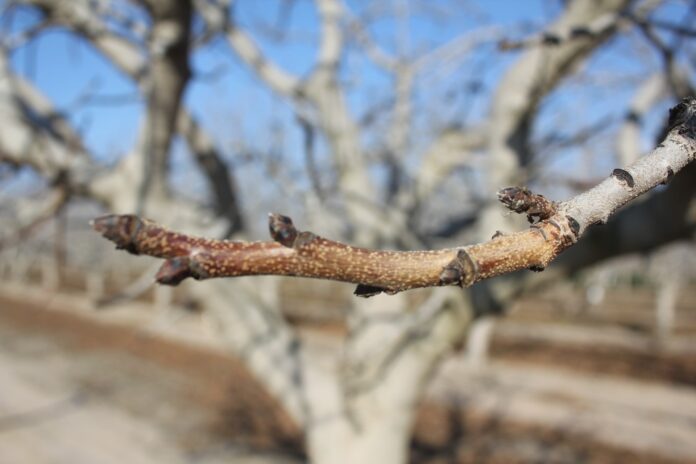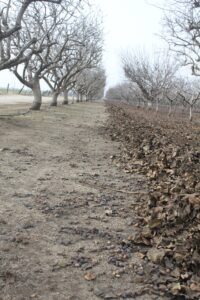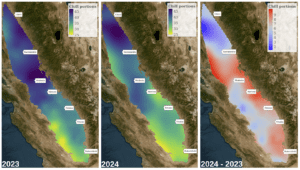
After the big chill year of 2023, California pistachio growers experienced a warm December and mostly warm January, sparking some concern that this ‘off’ year for pistachio production may only deliver marginal chill. Whether or not to assist trees in coping with a warmer winter period is up for discussion at press time.
Formerly, chill hours were calculated using the number of hours equal to or less than 45 degrees F accumulated over the dormant season. UC research notes not all “chill” is effective. When chill hours alternate with temperatures above 45 degrees F, a canceling effect can occur for some of that chill, and there is no way to measure this cancellation with the chill hour model.
The newer Dynamic Model is a way to compensate for temperature fluctuations. The model calculates chilling accumulation as “chill portions” using a range of temperatures from ~35 to 55 degrees F and accounts for chill cancellation by fluctuating warm temperatures. Calculation of chill portions begins September 1 instead of November 1.
Jordan Hazell, research manager for the crop management platform Semios, said in mid-January this season’s rate of chill portion accumulation has been notably less than the previous three years, aligning more with the pace of accumulation experienced during the chill season leading to the 2020 cropping season at this stage. He said compared to the chill season leading to the 2023 crop, all regions in this chill season have accumulated less chill portions thus far with the most prominent differences in accumulation being observed throughout San Joaquin County as well as the east side of the valley through Stanislaus, Merced and Madera counties.

Hazell said although more growers are familiar with chill hour utilization, chill portions are a more accurate indicator when it comes to predicting when to anticipate the effects of insufficient chill on budbreak and leaf-out in pistachios. It tends to better represent the nuances related to how the tree experiences borderline-optimal chill conditions.
UCCE Advisor Emeritus Bob Beede noted in his December Orchard Notes that fewer chill portions were recorded in December 2023 than the preceding December. The goal is to achieve 62 to 65 chill portions by about March 2. He said a summary from Advanced Nut Crop Sciences using still-active CIMIS stations showed 18% to 23% fewer hours below 45 degrees F than last year as of December 11.
Plant Scientist Gurreet Brar at Fresno State said the question of adequate chill has not been answered through research; however, the pistachio trees going into an off year are depleted for carbohydrate reserves, and a low-chill or marginal-chill year might adversely affect bloom and yield.

California Pistachio Research Board-funded research conducted by UC Davis Plant Sciences Professor Maciej Zwieniecki on seasonal dynamics of non-structural carbohydrates in pistachio trees found a strong correlation between yield and nonstructural carbohydrates in pistachio trees. In his 2020 report, he noted there is a strong incentive to develop techniques that allow trees to accumulate high levels of NSC prior to entering dormancy.
Rest-Breaking Agents
Brar said pistachio trees going into an off year are depleted for carbohydrate reserves, and a low-chill or marginal-chill year might adversely affect bloom and yield; therefore, applying a rest-breaking agent (RBA) might improve bloom synchrony, nut set and yield. He explained in California pistachio production, it is generally understood rest or endodormancy is completed roughly around mid-February. This is followed by a period of quiescence or ecodormancy, which is a period when the trees complete their rest/dormant period (a physiological requirement) and just wait for favorable environmental conditions so bloom can happen.
Hazell said there are multiple options being marketed when it comes to mitigating the effects of poor chill conditions. Those application-based options include hormone analogs, various nitrogen cocktails, hydrogen cyanamide (Dormex®), and use of kaolin clay.
Brar noted other known RBAs include ethephon, GA3, GA4, GA7, nitrate, garlic extract and horticultural oils. Historically, some of these chemicals were initially used for other purposes and were later discovered to have dormancy management potential. For instance, horticultural oils are the RBAs most used on pistachio in both California and Iran. In California, they remain licensed only for scale insect control.
Various RBAs affect the carbohydrate mobilization to the buds before bud break. RBAs might also cause better bloom synchrony between male and female cultivars as well as cause early bloom due to mobilization of some nutrient elements into buds and enhance pre-bloom bud respiration.
Brar said recent work at Fresno State suggested RBAs, like horticultural oils, provide significant results when applied around 55 or more chill portion accumulation. Dormex® application around 55 to 58 chill portion accumulation also resulted in significantly higher yield and split in-shell percentage in pistachios. In the trials, oil applications at 50 chill portions or less did not affect bloom time, synchrony or yield. However, the trials showed that timing also depends on other factors including location. Previous work by UC scientists suggested in central San Joaquin Valley locations, second week of February is usually the time to decide. However, Brar noted every site and every year has slightly different chill accumulation patterns and many years the calendar timing coincides with the 55 chill portion accumulation. In other years, the 55 chill portion accumulation does not occur until later in February or even March.
Brar said making an application based on chill portion accumulation milestones may be a better strategy than using a calendar date.
Aside from RBAs, another strategy to lower tree canopy temperatures and enhance chill accumulation in pistachio orchards entails use of a cover crop. Brar’s CPRB-funded research showed a cover crop in the orchard consistently advanced bloom in both male and female trees. A cover crop also advanced bud swell and full bloom stages around five to six days earlier than control plots.
He noted cover crops create a buffer between the soil and air, reducing the heat exchange.











